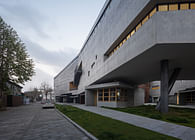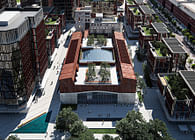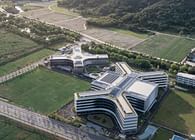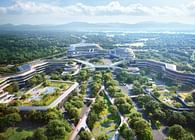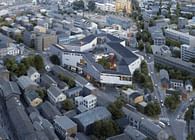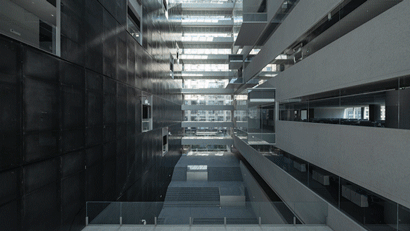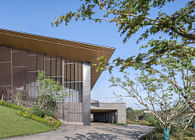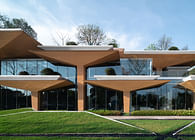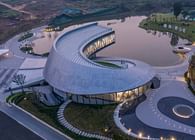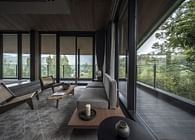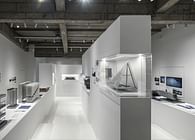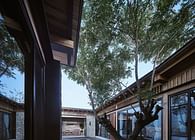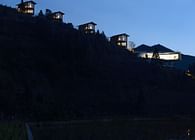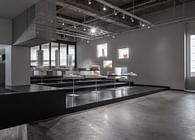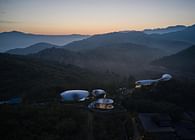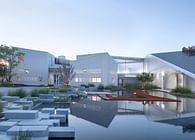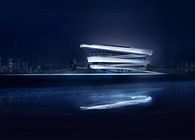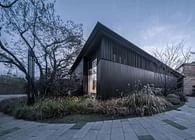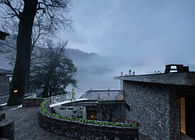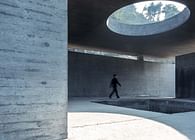
"Protection is intended to facilitate greater growth, and further protection can only be achieved through development. In fact, rural communities have the most vacant homes. The basic feature of rural revitalization is how to alter and renew existing structures in order to achieve long-term growth. In seven years, with fifteen guest rooms, we have seen the regeneration of a century-old ancient community." - Meng Fanhao
In 2016, the Ministry of Finance, the State Administration of Cultural Heritage, and the China Cultural Heritage Protection Foundation recognised Songyang as the sole county in China to carry out the "Save Old Houses Campaign" as a pilot county-wide effort. In the same year, the Songyang County government energetically encouraged rural cultural rebirth, as well as the preservation and renewal of historic villages. Chenjiapu Village, which was included in the third batch of China's Traditional Villages List, was part of this endeavour. At the time, Chenjiapu Village, which had existed for 640 years, had only a dozen old individuals and almost a hundred rammed-earth dwellings.
At the invitation of Xia Yuqing, the founder of JIESU, Meng Fanhao visited Chenjiapu Village. While amazed by the stunning setting suggestive of a secret paradise, they were also saddened by the historic village's vulnerable plight. Sharing a same goal of saving mountain communities from extinction, the two hit it off right away and went on a seven-year partnership and endeavour.
Chenjiapu Village, perched above high cliffs, is surrounded by mountains and overlooks a deep valley filled with clouds and mist. The village's rammed-earth and timber-framed dwellings are built along the slope, tiered with a steep drop of more than 200 metres. This arrangement depicts the usual settlement pattern of cliffside communities in southern Zhejiang.
Based on preliminary study and surveys, line+ has classified and organised architectural features and materials with regional peculiarities, including frames, roofs, walls, doors, windows, and structural details. This procedure entailed developing a local material and building technology lineage. The outcomes of this initiative will serve as a reference foundation for future refurbishment and redesign efforts.
Stray Birds Art Hotel's first phase, which included two refurbished guesthouses on the southern tip of the town cliff, was finished in 2018. It, along with other remodelling initiatives, helped to establish Chenjiapu Village's rural tourism. Five years later, the other, which included 11 guest rooms, a panoramic lobby, a cliffside café, and a restaurant, was finally finished. Chenjiapu Village has experienced a thorough change, emerging as a new type of rural tourism destination ideal for wilderness getaways.
01. Built along the Cliff, Optimizing the Structures
Stray Birds Art Hotel was originally planned as a full-service guesthouse complex that included accommodations, eating, and cultural events. It covered many residential structures near the village's southern end. The design's intricacy lay not just in modifying individual structures, but also in recognising the settlement's broader context and natural surroundings.
The location is reached by twisting and rugged mountain roads and over a hundred stone stairs from the village, and the view is obscured by houses. However, after passing through the spatial compressions, the perspective abruptly opens up, showing the canyon environs and giving the impression of a "journey to a hidden world." The site progressively stretches horizontally from east to west, becoming increasingly isolated as it moves westward, until it reaches the cliff at the end. The topography gradually declines from north to south, with several stone stairways down to the village.
The design team conducted on-site inspections of the ancient dwelling sites, retaining some rammed earth walls, stone walls, and functional buildings. They changed the functional arrangement to match the original spatial pattern. Three residential houses were chosen for the guesthouse's public spaces based on criteria such as accessibility and visibility. The hotel lobby and restaurant are positioned in the east, while the cliffside café is in the middle.
The remaining residential structures along the cliff were converted into guest rooms. To solve the elevation discrepancies, the design successfully used the existing east-west alleyway within the site: The house on the north side of the alleyway are aligned with the road at ground level, with direct entrance from the south-facing road; the dwellings on the south side of the alleyway, backed by the mountain wall, have second-story verandas that link to the road.
02. Adaptive Renovation for Rammed Earth Dwellings
The local government has strict regulations regarding the preservation of the traditional historical appearance of the village. The adaptive renovation is carried out respecting the village's architectural texture and adhering to the constraints of the residential plots. Most buildings are restored and updated using local materials, with partial modifications to openings. Collapsed structures are reconstructed within their original contours, and transparent glass boxes are strategically inserted at key locations to create a dialogue between old and new, traditional and modern, solidity and lightness.
Lobby
The original structure is a courtyard-rammed earth and timber-framed house, with the courtyard and agricultural implements room on the west side collapsed. The entrance hall and back chambers' layouts have been preserved during the refurbishment. The courtyard has been reconstructed as a central landscaped courtyard, with the front hall acting as the reception hall, the second floor of the rear chambers as staff offices, the east wing as a tea parlour for short stays, and the west wing linking to the entrance and guest rooms. A corridor is used to provide two circulation channels for visitors and employees.
The rammed earth walls of the reception lobby are protected and repaired, while the internal structure undergoes major renovations using traditional methods. On the west side, a glass box is inserted within the original residential plot, creating a sunken relaxation area. With three sides opening up to the surrounding mountains and valleys, the scenery of lush pine trees, bamboo, and drifting clouds is fully visible.
Restaurant
The original structure is a two-story rammed earth home with some of the second-floor walls collapsed. Due to restricted views, the bottom level has been repurposed to house the kitchen and ancillary facilities, with the room on the west side, immediately facing the valley, designated as a picturesque eating area. The design features lightweight steel prefabricated buildings for the eating area, providing a clean 270-degree perspective. Large glass windows and flexible vertical folding windows are employed to fully capture the magnificent mountain landscape within.
Cliffside Café and Tearoom
The original site featured a three-story brick building descending down the cliff, with a steep slope backed by a stone wall and the roof used by villagers for drying purposes. Following the spatial layout of the site's layers, the middle level crossed by the alleyway is designated as the ground floor level for the café, with the second floor housing a bakery workshop, and the basement level serving as the tearoom. After repairing the original steep slope and removing the collapsed dilapidated brick walls, new rubble stone walls were constructed. The original flat roof was replaced with a single-sloped roof, with the ridge height aligned with the upper window sills and the eaves remaining unchanged. This design not only maximizes the space for equipment indoors but also retains the scenic view from the upper level to the greatest extent possible. The second-floor single-sloped roof opens towards the valley, opposite to the same level.
The café features a covered outdoor space at the entrance, integrating panoramic floor-to-ceiling folded windows. Taking advantage of the lower roof as a scenic terrace, the design extends the originally small indoor space outward.
On the west side of the café, the traffic core revolves around a large tree. A staircase on the ground floor spirals up from the base of the cliff, while a second-floor corridor encircles the tree trunk before re-entering the indoor space. Through a series of spatial transformations, the café engages in dialogue with the environment. Eventually, the entire café gently leans against the cliff wall, nestled beneath the growth of the large tree.
Descending along the stone steps beside the café's scenic terrace is a tearoom transformed from an old woodshed. The design respects the natural form of the original building hanging on the cliff wall. By protruding towards the valley side and incorporating floor-to-ceiling glass windows on the southwest sides, it appears as if a lightweight box is growing out from the cliff wall.
Guest Rooms
As the other old structures for the guest rooms were all in unsafe condition, only some viable ancient walls and recycled components were kept. While preserving spectacular views from the guest rooms and widening the door and window openings, the texture of the remaining external walls preserves the structures' original shape. This involves preserving ornate woodwork pieces, rammed earth, cornices, and other architectural features that have been repaired with modern technology.
Building A has rammed earth walls on three sides. The south facade was restored to its original look, with metal window frames affixed to the apertures and a picturesque observation platform built beneath the eaves. After eliminating the ancient and deteriorating timber framework within, a lightweight steel structure was built to satisfy the functional needs of the guest rooms. Eventually, the old tiles were replaced. Following landscape improvement, the outdoor platform may be used for activities such as sun-drying by locals.
Building D suffered severe collapse. The old structures are restored to keep their unique rammed earth walls, but new builds use local rubble stone as facade materials. These two native materials cohabit peacefully in the setting of ancient and new. The interior layout integrates with the terrain, accessed from the second-floor platform, descending via a spiral staircase to the living room and bedroom on the first floor. The living room features a double-height space, offering a panoramic view of the entire gorge landscape. Indoor activities extend outward to the outdoor courtyard.
In the interior design of the guest rooms, while respecting the principles of land allocation, seven different room layouts were designed to respond to the complex natural environment of the mountainous terrain, utilizing the characteristics of each residential plot. The living area of each room is positioned near the road, while the bedroom and bathtub face the scenic views, ensuring both privacy and optimal landscape views.
03. Building Together with Villagers, Sharing with Villagers
The project is constructed by the village construction team. On one hand, tasks such as repairing rammed earth walls, building stone walls, constructing stone steps, and laying blue tiles rely on the collective experience of the villagers. On the other hand, due to the winding village roads and rugged stone steps, with some narrow sections allowing only one person to pass at a time, large construction machinery cannot enter. Therefore, all transportation must be carried out manually, one trip at a time.
This construction model not only rekindles the villagers' sense of belonging and identity but also ensures the maximum protection and inheritance of traditional cultural memories.
04 Revitalizing the Ancient Village with Stray Birds Art Hotel
In the early years, according to the planning policies, all residents of Chenjiapu Village were to relocate from the mountains to alleviate poverty, and the hundred-year-old village was slated for demolition. Fortunately, due to the persistence and efforts from various parties, along with support from new policies, Chenjiapu Village has been preserved intact and has undergone a completely new development.
It's reported that in 2022, Chenjiapu Village received over 300,000 tourists, generating tourism revenue of over 19 million yuan, leading to an average increase of 20,000 yuan in income per household for the remaining residents. Among these developments, the Stray Birds Art Hotel maintains an average room rate of 1,500-2,500 yuan per night, with a year-round occupancy rate of over 90%.
Furthermore, Stray Birds Art Hotel has always adhered to the mission of "revitalizing a village with each homestay." Since its establishment in Chenjiapu Village, it has been actively promoting rural revitalization. Apart from providing employment opportunities and training villagers in cultural and tourism-related skills, the hotel also assists villagers in selling dried sweet potatoes, high-altitude vegetables, and other agricultural products. Through rebranding and positioning, establishing e-commerce channels, and conducting marketing, thousands of kilograms of dried sweet potatoes are sold out within just 3-5 days each year.
The ultimate goal of preserving traditional historical villages is to facilitate better development. Behind the strict control of the architectural style lies the need to accommodate new functional formats. Rural development not only relies on the natural environment and traditional culture but also requires the introduction of external resources. This includes not only tourists and commercial activities but also industrialized construction systems. While creating more economic benefits for the local community, integrating and updating local construction techniques also guides villagers to protect traditional villages while pursuing development in parallel. line+ is fortunate to have been a participant and witness to this process. Over the course of seven years, it has fulfilled the dream of the mountains: "To rekindle the beauty of the wilderness and rediscover the heart of the new village."
Status: Built
Location: Lishui, CN
Firm Role: Architecture
Additional Credits: Project Name: Songyang Stray Birds Art Hotel
Design Firm: line+ studio
Chief Architect/Project Principal: Meng Fanhao
Design Team: Xu Tianju
Client: Songyang Leila Private Travel Culture Co., Ltd., Kongshanji Inn
Operator: Songyang Feiniaoji Cultural and Creative Co., Ltd.
Structural Coordination and Construction: Hangzhou Zhongpu Building Technology Co., Ltd.
Interior Design (Restaurant): Guantang Design
Construction: Shanghai Chenggong Construction and Decoration Engineering Co., Ltd., Taizhou 707 Engineering Decoration Co., Ltd.
Project Location: Zhejiang, Lishui, Songyang
Building Area: 1381 square meters
Design Period: 2021/07 - 2022/07
Construction Period: 2023/03 - 2023/12
Structure: Prefabricated light steel structure with thin walls
Materials: Rammed earth, rubble stone, lightweight concrete, bamboo and wood exterior panels, glass, aluminum sheet
Photography: Xi Chen + Chris King, Tang Xuguo, line+







